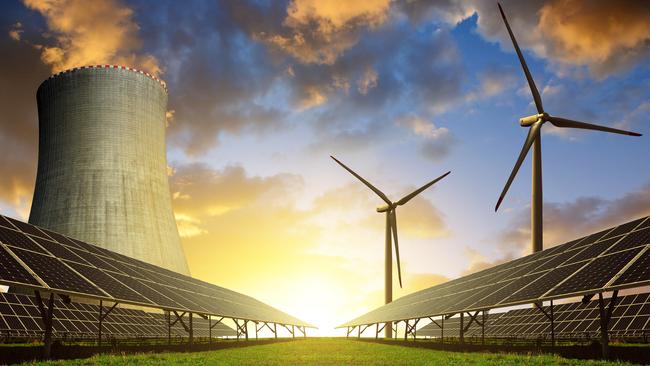We’re powering ahead on a hi-tech energy superhighway
The government’s energy ‘roadmap’ must be extended to include other rapidly developing innovations.

Computer giant IBM was placing its bet on artificial intelligence to accelerate work on ways to capture CO2 from the air more effectively and transform it into useful products and components, resulting in cleaner air and a cooler planet.
Nuclear energy company NuScale has finally received the first safety approval certificate issued by US regulators for a small modular nuclear reactor.
And in laboratories around Australia and the world, scientists are developing new metals and materials they hope will help to solve a new era of problems in the green energy marketplace.
The starting point for government, big business and researchers is the same — to play to their existing strengths. Ultimately, success will come down to a simple equation: scale and cost.
Tesla is working on new battery cells it says will cut costs and dramatically extend the range of electric cars to make electric vehicles cost competitive with petrol and diesel cars.
“Sustainable energy is going to be lower cost, not higher cost, than fossil fuels,” Musk says.
Taylor describes Australia’s technology roadmap as a portfolio “bet” focused on areas where the nation has a natural advantage. The benchmark is that new processes to make green steel or aluminium must be the same price or cheaper than the higher emissions status quo.
“That way you don’t have to impose a tax and make things more expensive for people,” Taylor says. “We know this works because this has been the history of technology through the world that new lower-cost technologies emerge that offer consumers great advantage over existing alternatives.”
The lesson from the failure of the Copenhagen climate conference was that developing nations were not willing to sacrifice prosperity for the environment. It remains a fact that China, the world’s largest emissions nation, is continuing to invest heavily in coal-fired power plants at home and around the developing world. At the same time, President Xi Jinping told the UN this week that China intended to peak its carbon dioxide emissions by 2030 and was striving to be carbon neutral by 2060.
Taylor says Australia will stick to its existing targets of cutting emissions by 26 per cent from 2005 levels. Under the Paris Agreement, Australia is expected to nominate a 2035 target in two years time.
The mega trend is undeniably for a lower-emissions future.
The technology roadmap is one part of a suite of energy and emissions reforms launched by the Morrison government. It identifies clean hydrogen, electricity from storage and firming, low-carbon steel and aluminium, carbon capture and storage and soil carbon as priority issues.
For hydrogen, the ambition is to get production costs below $2 a kilogram. A target for long-duration energy storage was set at less than $100 per megawatt hour to enable wind and solar to be delivered at prices around or below today’s wholesale price.
For carbon capture and storage, the ambition is for CO2 compression, transport and storage at under $20 a tonne.

The other targets are low emissions steel production at under $900 per tonne, aluminium at less than $2700 per tonne and soil carbon measurement for less than $3 per hectare per year.
The government’s approach has had its detractors. But behind the noise, the big picture for how Australia will navigate a path to reduce emissions while building resilience in a period of global upheaval is becoming clearer.
When the full suite of policy measures — including investment support for new technologies and land-based carbon sequestration — are assessed, a coherent energy and environment policy is taking shape.
The government says gas will be critical to rebuilding manufacturing and securing reliability in the electricity grid until other options become a reality. Support for new transmission infrastructure will enable the rollout of more renewable power. New competition in gas marketing and delivery should strengthen the hand of manufacturers, and big gas exporters will be under more pressure to better service the domestic market.
The government has recapitalised the Clean Energy Finance Corporation and Australian Renewable Energy Agency and changed the mandate to allow investment in “low-emissions” technologies. While much of the angst has been focused on electricity, the government’s plans acknowledge many of Australia’s energy problems and carbon dioxide abatement challenges lie outside the electricity sector.
Financial markets are certainly more alive to the opportunity of land-based measures. The outlook for land was explored at a Carbon Market Institute conference this week by Taylor and economist Ross Garnaut.
Taylor told the conference the challenge was to measure soil carbon at low cost. He said satellite imagery and remote sensing offered the promise of affordable abatement at scale. Big finance and big industry are moving into the land sector abatement space, with recent investments by Shell and fund manager KKR. The emissions savings opportunity from the land sector is estimated at 90 million tonnes a year, or 20 per cent of Australia’s emissions.
Andrew Liveris, the former Dow Chemicals chief executive playing an increasingly influential role in shaping the federal government’s post-COVID-19 economic policies, would have surprised many by his press club address earlier this month when he supported a carbon-neutral target for 2050 and the renewable energy transition. He outlined how investment in gas infrastructure was a positive for a renewables based hydrogen industry, which could one day feed into the government’s proposed Henry Hub-style pipeline network.
Liveris says that, together with a reversal of globalisation and the rise of digitalisation, artificial intelligence and big data, the sustainability mega-trend will define the 21st century. “We are seven billion people moving to nine billion and the planet is bursting at its seams,” he says. “Continuing to stress our ecosystems will produce calamity on a scale at least as profound as what we are experiencing with the pandemic.”

Technology and economic resilience are critical to meeting the challenge. Solving the issue of intermittency with wind and solar is a major global priority. Musk is betting heavily on improving the manufacture and performance of lithium ion batteries.
For scale, professor Erich Kisi from the University of Newcastle has developed new materials that can be made into bricks and used to store heat. Kisi envisages towers of the new blocks to replace boilers at decommissioned coal-fired power stations. The new technology offers the potential of storage at an estimated one-tenth the cost of lithium ion batteries.
“My grand vision is any time there is spare generation anywhere on the grid it could be parked in storage and then redeployed later,” Kisi says.
Llewellyn Owens from Providence Asset Group is overseeing a $500m rollout of small-scale solar farms with storage using hydrogen. The technology, developed at the University of NSW, is able to store hydrogen safely and efficiently at a low pressure in a metal sponge connected to the solar photo voltaic array.
Owens says the system includes some lithium ion batteries but has a big advantage because energy can be stored for longer and the material can be recycled.
At present, the technology costs about $140 to $150 a MW/h including the solar, compared with lithium ion batteries at about $120 to $130MW/h. Owens says the technology is at the start of its cost curve and prices should be able to come down to $80 MWh.
The Newcastle University and UNSW technologies are only two of a raft of possible solutions now in development. Others include better grid management and ways to make energy use more efficient.
The challenge is to have the new storage technologies and other systems scaled up to replace what is lost from existing base-load coal plants as they are retired.
The view from the top, including that of Chief Scientist Alan Finkel, is that coal and gas will be needed for at least a couple of decades yet. But innovation is the way to the future.
“It’s actually a remarkably consistent part of history,” Taylor says. “We see a challenge and we overcome it with a better way, a faster way, and a more cost-effective way.”




As Energy Minister Angus Taylor laid out the Morrison government’s technology roadmap for lower carbon dioxide emissions this week, car maker Elon Musk was busy putting a new lane on Tesla’s battery superhighway.